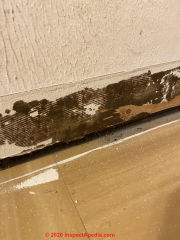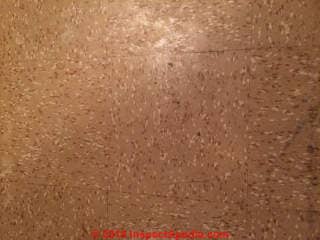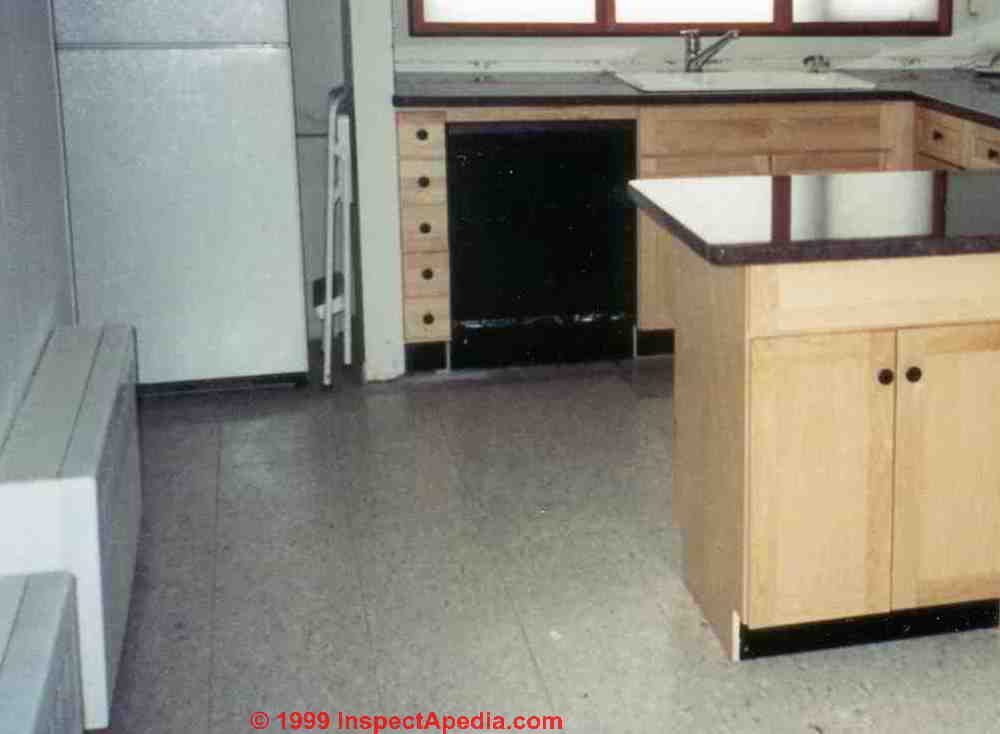 FAQs on How to Leave Asbestos Tiles In Place
FAQs on How to Leave Asbestos Tiles In Place
Q&A on how to Seal Floor Tiles That May Contain Asbestos
- POST a QUESTION or COMMENT On how to minimize the risk of asbestos floor tile contamination in a building
Questions & answers about how to use a sealant to leave asbestos flooring safely in place.
This article series describes strategies for leaving asbestos-containing floor tiles or sheet flooring safely in place in a building:
Page top photo: vinyl asbestos floor tiles in the kitchen of a 1970's home - before covering over with epoxy floor paint.
InspectAPedia tolerates no conflicts of interest. We have no relationship with advertisers, products, or services discussed at this website.
- Daniel Friedman, Publisher/Editor/Author - See WHO ARE WE?
FAQs on Using a Sealant to Safely Leave Asbestos Flooring in Place
These questions & answers about sealing asbestos-containing floor tiles or sheet flooring were posted originally
at ASBESTOS FLOORING LEFT IN PLACE - be sure to review the sealant advice given in that article.
Asbestos is safe and legal to remain in homes or public buildings as long as the asbestos materials are in good condition and the asbestos can not be released into the air. - US EPA
On 2020-11-01 - by (mod) -
Judy
Please read
ASBESTOS FLOORING LEFT IN PLACE using an expoxy floor paint over asbestos-containing floor tiles or sheet flooring.
https://inspectapedia.com/hazmat/Asbestos-Floor-Tiles-Left-in-Place.php
On 2020-11-01 by Judy P
We have a large basement rec room flooring with asbestos tiles. It’s in good condition but I don’t like the idea of it being asbestos. What is the best thing we can use, other than tiling or carpeting over it. Are there good sealers that will work?
On 2020-09-07 by (mod) - clean paint spots off of antique linoleum flooring
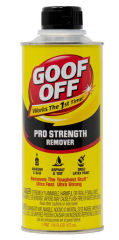 Oil
Oil
Try some simple solvents, starting always with the simplest:
Water
A simple wax stripper to remove old floor wax
Goof-Off or similar stain removers will work on some latex paints (be patient)
Odorless mineral spirits
Beware that other solvents like lacquer thinner can dissolve and damage the flooring
On 2020-09-06 by oilcan
I have a 1920's home. There is asbestos sheet flooring in the kitchen and it's beautiful. I'd love to clean some paint spots off of it, "how" is my first question. Second, what product do you suggest for sealing the floor?
On 2019-11-12 by (mod) - treat pre 1980s black asphalt based floor tiles as "PACM" Presumed to Contain Asbestos & avoid making dust
 Garrett
Garrett
Those black asphalt asbestos floor tiles suggest that your house was built before the 1980s, perhaps in the U.S. in the 1960s or earlier?
They look like an Armstrong asphalt asbestos floor tile such as described at ARMSTRONG FLOOR TILE IDENTIFICATION - 1951 - 1986 asbestos
https://inspectapedia.com/hazmat/Armstrong_Tile_List_1951-59.php
It is almost always safest and least costly to leave such flooring in place and to cover it over with new flooring material just as you suggest.
If you are going to do that, and if you are not faced with a costly dusty demolition project, then in my opinion treating the floor as presumed to contain asbestos, leaving it in place, and covering it, is the safest, most-recommended, and least-expensive approach. Testing would not be necessary.
On 2019-11-12 by Garrett
We recently removed a few plastic tiles in our basement to uncover what looks like asbestos tiles.
A little of the tile peeled off when we pulled them up (see image). Should we get this tested, or is it safe to just leave tile as is and layer on new plastic tile?
On 2019-09-22 1 by (mod) - asbestos in wall base adhesive mastic
That mastic could contain asbestos, James; one would need to know more:
such as the country, city, and age of the building if not of the floor wall base installation itself; keep in mind that mastic isn't generally friable.
See ASBESTOS-CONTAINING ADHESIVES https://inspectapedia.com/hazmat/Floor_Tile_Mastic_Asbestos.php
Keep in mind that flooring mastic adhesive as well as vinyl- or asphalt-asbestos floor tiles are not friable
- not easily made into hazardous dust.
The best course if you can avoid a dusty demolition is to leave the mateirals in place, covered-over.
On 2019-09-22 by James
Can anybody tell me if this [photo above] could be asbestos?
It’s adhesive from wall base
On 2019-08-26 by (mod) -
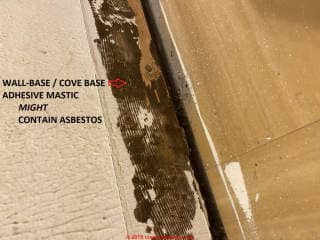 If the asbestos suspect flooring was stapled and not simply glued down it should be easy to Simply remove it. If it's glued down then you could cover it over with new flooring material
If the asbestos suspect flooring was stapled and not simply glued down it should be easy to Simply remove it. If it's glued down then you could cover it over with new flooring material
On 2019-08-25 by Anonymous One
I recently pulled up the carpet in some stairs in my 1960s house. Vinyl sheeting that is very likely to have asbestos backing covers both the treads and the risers, capped with aluminum nosing.
We pulled out the staples and tack strips before we realized it could potentially have asbestos.
Because of this, there are some small holes/chips in the vinyl sheeting and I am concerned this could result in the asbestos backing being disturbed. I would like to encapsulate the stairs in epoxy but wasn’t sure if it’s even possible.
I’ve read how to epoxy wood stairs but ours are covered in vinyl sheeting.
Similarly, I’ve read how to epoxy vinyl sheeting but not when it’s on stairs or otherwise vertical like the risers are. Should it be possible? Also, to safely encapsulate it do I need to cover the aluminum noses as well or would it be enough to seal the meeting point between the nose and the tread?
Thank you for this invaluable resource!
On 2018-12-12 by (mod) -
Anon:
How to post a photo or image at an InspectApedia.com web article.
Type a comment like mine.
Click the Add Image button.
A window will open on you computer or phone.
Navigate to where your picture is located on your computer or phone and select it.
THen when you click the "Comment" button both the comment and the photo will post - but the actual photo won't be visible to others until it's approved by the moderator. That's to protect both the website (from viruses) and readers (from inappropriate content).
On 2018-12-12 by Anonymous
could anyone give advice on this trying to post a pic
On 2018-10-15 by Lorilee
Thank you for your help
On 2018-10-11 by (mod) -
No you don't need to etch a vinyl or asphalt tile floor before painting with epoxy. Etching is for raw concrete surfaces.
We use a wax stripper to remove all coatings from the existing floor. Clean and *dry* the surface thoroughly.
Do not use abrasives such as sanding as that is not necessary and risks releasing airborne asbestos-laden dust.
See FLOORING ADHESIVE MASTIC SEALANTS for sealants that improve bonding if not all of the original cutback adhesive was removed or to improve bonding of any floor lever or new flooring adhesives.
On 2018-10-11 by Lorilee
We have idenitfied asbestos tile on our breezeway that was discovered when we removed carpet. It is in remarkably good shape with only a few crumbling tiles at the edges of doorways.
We removed the glue (mastic) and are considering an epoxy coating to seal it.
Most postings I have read about prepping for epoxy say to etch a concrete floor in order for the epoxy to adher properly.
I can't find any info on whether or not it is necessary to do this when applying it to asbestos tile. Is it even safe? Does it need to be primed first or any other specific prep that differs from applying it to concrete? Thank you
On 2019-09-22 by (mod) - does this cove base adhesive contain asbestos?
 That mastic could contain asbestos, James; one would need to know more: such as
That mastic could contain asbestos, James; one would need to know more: such as
- the country, city, and age of the building where the adhesive was used
- If possible, the age or dates of the floor wall base installation itself;
Keep in mind that mastic isn't generally friable so is not particularly hazardous unless it is chopped, sawn, ground, made into a dust that can become airborne. .
See ASBESTOS-CONTAINING ADHESIVES
On 2019-09-22 by James - wall base adhesive asbestos?
Can anybody tell me if this [black adhesive mastic shown above] could be asbestos? It’s adhesive from wall base
On 2019-04-03 by (mod) - ok to tile over stairs as a sealing means?
Fred
With the reclama that I can't see your stairs, sure in principle the walking surface can be re-tiled.
However if using thick tile coverings, say more than about 1/8", there may be a change in riser height from the consistent one along the stairs, when you reach the final uppermost riser and first lower-most riser if those floors are not also re-tiled, but if the new flooring is thin enough you'll be in-spec.
No step to step walking surface height variation should be greater than 0.375 inches
See details at STAIR RISER SPECIFICATIONS
On 2019-04-02 by fred west
I have stairwell that goes from the basement to the third floor apartment can these tiles be sealed and retiled. Is there good company close by you could recomend i live in Cicero Ill 60804
On 2019-01-31 by (mod) - ok to use epoxy paint on asbesto flooring, then tile over?
That will work fine provided you're sure to wait long enough for the epoxy paint to cure and Harden.
Watch out: Don't stick your new tiles on too early or they may simply pull off the paint.
Watch out: Keep in mind that for a successful Epoxy paint coating on Old floor tiles you need to clean the tiles including using a wax stripper to remove old wax. You don't need and don't want to use abrasives, steel wool, Etc.
Really? If you are planning to cover over asbestos containing flooring with new tiles or sheet flooring, I'm unclear why you need to paint with expoxy. I used a liquid wax stripper to clean the old floor to get a good bonding surface, then simply glued down new flooring.
On 2019-01-30 by jennifer haldane
if I seal my tiles with an epoxy paint and sealer can I then stick new tiles on the top.
On 2018-12-15 by Rhett
Thank you . I have done the repairs and all seams good. Thank you for your help. Regards
,
On 2018-12-10 by (mod) - Filling in the few small damaged areas and leaving the otherwise secure floor tiles in place
Filling in the few small damaged areas and leaving the otherwise secure floor tiles in place is generally the recommended approach. So what you're describing sounds right to me.
On 2018-12-10 by Anonymous
Hi all. I have just bought a house and removed carpets prior to vinyl flooring going down next week- which in itself is a 1-2 year temporary floor before we can afford tile, wood etc.
The floors all have 9x9 marley style tiles which I have and will assume contain asbestos. They are in generally good shape just some cracks around the edges where i removed the carpet tack strips (p.s I did wear ppf3 mask for whole process)
I want to leave them in place and just fill the few small cracks around the edges near the skirt just to get them level for the vnyl floor going down, no one cracked piece at the edge is bigger then 1"x6" the carpet tack strips where nailed in so its just a bit of light damage where these were removed.
Can I just apply a little concrete water seal in these spots then fill these with a basic polyfiller just to get level enough to put vinyl over. Low budget and dont want to overcomplicate this issue. The tiles can stay there happily just want to fill the small edge cracks flattish. I dont want or need to remove the marley tiles at this stage and then use levelling compound.
I dont reall know how i would get damp arise from this as some have mentioned in forums as if that was the case it would come up under the skirt and edges after the natural point the marley tiles finish. Thank you all for any simplifies help you can offer. Regards Rhett
On 2018-09-16 by Inge
I have a question on asbestos containing linoleum tile in a condo with concrete slab. I would like to place acoustic underlayment and then ceramic tile on top. Is this possible? What type of mortar / adhesive is appropriate for fixing the underlayment and ceramic tile atop The linoleum?
On 2018-09-02 by (mod) - ok to pour concrete over bits of old tile mastic?
Yes, Thomas that's safe. The concrete needs to be thick enough to stay in place.
On 2018-09-01 by thomas koudellou
my 1920's building was flooded.A lot of tiles 9X9 were detached from the floor.Remaining mastic showed asbestos.I can't afford to abate the area .Is safe to cover mastic with concrete
On 2018-10-11 by (mod) - don't need to etch a vinyl or asphalt tile floor before painting with epoxy
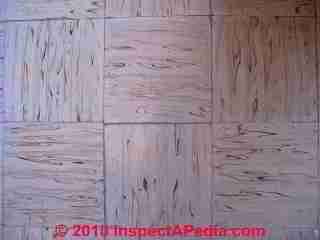 No you don't need to etch a vinyl or asphalt tile floor before painting with epoxy. Etching is for raw concrete surfaces.
No you don't need to etch a vinyl or asphalt tile floor before painting with epoxy. Etching is for raw concrete surfaces.
We use a wax stripper to remove all coatings from the existing floor. Clean and *dry* the surface thoroughly.
Do not use abrasives such as sanding as that is not necessary and risks releasing airborne asbestos-laden dust.
On 2018-10-11 by Lorilee
We have idenitfied asbestos tile on our breezeway that was discovered when we removed carpet. It is in remarkably good shape with only a few crumbling tiles at the edges of doorways. We removed the glue (mastic) and are considering an epoxy coating to seal it.
Most postings I have read about prepping for epoxy say to etch a concrete floor in order for the epoxy to adher properly.
I can't find any info on whether or not it is necessary to do this when applying it to asbestos tile. Is it even safe?
Does it need to be primed first or any other specific prep that differs from applying it to concrete? Thank you
On 2018-09-26 by raebrea5
Thank you for your help.
On 2018-09-26 by (mod) - old flooring mastic can be left in place
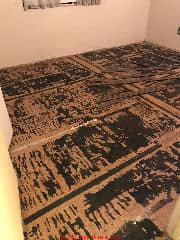 Rae
Rae
For a floor whose tile is not coming up it is safer and more-economical to leave it in place.
But you may not be successful painting over flooring on which remnants of previous mastic, carpet underlayment, or other material remains partly adhered - the stuff you think is a black mastic.
Some mastics also contain asbestos and need to be handled accordingly.
Some can be removed with water as a solvent, others require an organic solvent;
Or you'd leave the thin mastic in place and cover over the floor as you planned in the first place; sheet vinyl is quick and relatively inexpensive.
See procedures and sealants that can be used over tile mastic
at ASBESTOS FLOORING LEFT IN PLACE
On 2018-09-26 by raebrea5
I found this article very helpful. My husband and I pulled up carpet in our 1958 home discovering cork-looking asbestos tiles in each bedroom.
We plan to install a floating laminate or vinyl flooring throughout the home in the future, but for now need a solution for the asbestos tiles (we have two large dogs).
We were debating abatement, but after reading this article are now considering a dark colored epoxy floor paint. Although, I am not sure how to approach cleaning the floors because one of the rooms may have had another floor on top of it at some point because it has what I believe to be black mastic (maybe) all over it.
Any advice or confirmation of epoxy being a good option is much appreciated. Happy to provide additional photos, if requested or helpful. Thank you!
...
I found this article to be very helpful. My husband and I pulled up carpet in our 1958 home over the weekend discovering cork looking asbestos tiles. One room appears to have had another flooring atop it because I am fairly certain it has a black mastic on top of it.
We are having a debate whether to abate the tiles or use a dark colored epoxy floor paint (most likely a 1-part epoxy floor paint from local stores).
This article has me leaning toward using the epoxy floor paint. Although, the cleaning of the floors may prove difficult (see picture).
Eventually, we would like to cover the floors with a floating laminate or vinyl. Any advice or confirmation we are on the right track would be appreciated. Thank you!
On 2018-09-15 by (mod) - what epoxy paint did you use to seal asphalt or vinyl asbestos flooring?
Yes I think any epoxy floor paint will work fine. What's important is to clean the surface thoroughly so that the paint will bond will. We use a liquid wax stripper.
For just filling small voids around the perimeter of the floor where you are out of a traffic area, a thinset concrete leveling compound may be fine.
On 2018-09-13 y Donna
I am trying to paint over asbestos tiles. Around the perimeter, some tiles are broken. Can you recommend a floor filler brand? Also, should I use a primer such as Zinsser, before I paint. And what epoxy paint did you use?
I found a concrete /garage paint with epoxy, will this work?
Thank you.
On 2018-07-09 5 by Teresa
I hope you can help me figure out what I should do about the asbestos tile in basement. Okay the tiles are 9 x9 and brown or black and tan.
Pretty sure house built in 50s. Some of the tiles are loose but others seemed to be still stuck well. We have a water problem in the basement I would like to seal the floor and go up about 6 to 12 inches on the wall. Do I have to remove all the tiles or just loose ones.
Also what would be the best product to use to seal the floor. I'm doing this myself so please help for the best way to do it. But most of all want to make sure that the water
On 2018-06-29 by (mod) -
You can try the methods discussed in this article if the floor is in good condition, or you can install a new layer of flooring atop the existing one -
see ASBESTOS FLOORING HAZARD REDUCTION
On 2018-06-28 by JIm
From your pictures I identified the flooring in my basement as vinyl asbestos. What method of covering over it would you recommend please?
Thank you
On 2018-06-11 by (mod) - Asbestos-containing chip patternsheet flooring
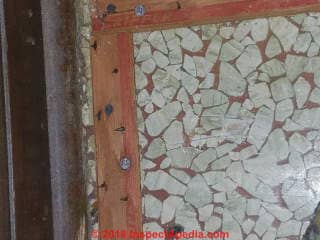
Slicing with a box knife should not be a source of a noticeable amount of dust or debris.
You should be fine with covering the floor over with new material as long as removing the tack strips isn't breaking it up and causing a Dusty mess.
Damnp wipe any small amounts of debris that you find.
On 2018-06-10 by sarah.thomson089
I may be sending this more than once but I'm not sure if I'm doing it right. I bought my grandparents house, built in the late 60s.
Peeled back a spot in the kitchen hoping to find wood and found what i think now is asbestos sheet flooring. I sliced the floor to try and find wood before I realized what it was.
My question is can we rip up the tac strips and carpet to lay new laminate wood or should we do something to the nail holes and slice mark before?
I attached a picture of the spot I peeked at.
On 2018-04-21 by (mod) -
That's tough to assess for a floor whose condition we don't know. In general we would expect there to be no measurable asbestos hazard for carpet covered asbestos-containing floor tiles.
On 2018-04-21 by Erin
Thanks for the quick response! Unfortunately I didn’t think to take pictures before it was covered up by carpet.
My only concern is the parts of flooring underneath the carpet that aren’t in great condition..
.like where the vinyl had come off and left backing that is only covered by carpet padding and carpet. I just wasn’t sure how much, if any, further damage walking around on carpet could do if there’s something friable underneath.
On 2018-04-21 by (mod) - found a sheet vinyl flooring
I'd like to see photos of your flooring - use the picture frame icon next to the Comment button.
Don't panic; if the floor is in good condition the hazard of airborne asbestos will be below the limits of detection as long as the floor is not chopped, ground, sawn or otherwise made into a dusty mess.
On 2018-04-20 by Erin
We recently had carpet replaced in our living room and found a sheet vinyl flooring underneath that we didn't know about.
The carpet installer insisted that he knew it wasn't asbestos, but I had a loose piece of it tested anyway, and the backing turned out to be 95% asbestos.
The sheet flooring didn't cover the whole room- it seemed like someone had haphazardly removed about half of it already.
There were some smaller places where the backing was bare and the top layer was not even there. By the time I learned about the asbestos content, new carpet had already been installed on top of it. In this situation, do you think a carpet pad and carpet are enough to keep us safe, even where the backing is bare?
I am willing to have someone tear it up now and encapsulate it better, but would rather wait until we naturally need this carpet replaced if possible.
Thanks for any help you can give!
On 2018-04-08 18:41:08.761643 by (mod) -
Sounds reasonable. Let us know your test results as that will help other readers.
On 2018-04-08 by Scott
I’ll be covering the floor in either outcome after I send a tile for testing. Unfortunately the owners left spare tiles without the box they came in.
On 2018-04-07 by (mod) - cork pattern floor tile may contain asbestos
Your photo (above) looks like a cork-pattern vinyl asbestos floor tile.
You'd need either be certain of the date or have a sample tested.
Search InspectApedia.com for ASBESTOS TESTING LAB LIST if you need to do that.
Safest is to leave such a floor (in good condition) intact, clean and seal it or cover it over.
On 2018-04-07 by Scott
I have a feeling that the tiles in the home I just purchased have asbestos in them since they were installed in 1959.
Can any tell for sure by looking at this picture of a 9x9 tile?
On 2018-03-25 by Walt
Thanks! InspectApedia is a great resource - I appreciate the quick reply, even if I didn't have time to check the site until today.
On 2018-03-19 by (mod) -
At PERM RATINGS of BUILDING MATERIALS https://inspectapedia.com/interiors/Perm-Ratings-for-Materials.php
We report that most sources count the perm rating of vinyl flooring as close to zero.
On 2018-03-17 by (mod) - contemplating using epoxy over 9x9 tiles
Walt,
In my opinion as well as in my direct experience with these floors since the 1940s (ok I was a boy playing in the basement), the articles warning that moisture below vinyl or asphalt asbestos tiles are right that wet conditions or moisture can cause the tiles to come un-glued.
We see that in basements subject to water entry as well as following single-event floods.
But adding epoxy or any other coating on top of such floor tiles will not cause a release problem provided the tiles are securely
glued down at the time.
That's because the perm rating of this flooring is so low (The perm rating is about 0.3, well below 1) that the top coating of epoxy makes not one iota of difference in the overall permeability of the floor covering.
In other words, IF there IS already a problem with water or moisture below glued-down asphalt or vinyl asbestos flooring tiles then it will tend to push up the floor.
By no stretch of the imagination does a vinyl or asphalt asbestos floor breathe through enough moisture to avoid becoming unglued if there is moisture under the floor. Moisture present = problem. Moisture absent = no problem.
Coating the floor doesn't change its overall perm rating in any significant way. (And no we're not relying on moisture exiting at the butt joints between tiles to prevent flooring release. That would never protect a floor from losing its adhesion due to moisture below )
Thanks for the nice note, Walt. We work hard on our information so I'm especially grateful when a reader finds it useful.
Help me out by taking care to put the A in InspectApedia.com as there are several fellows who snark up our traffic by having registered
lookalike names with that middle i or o.
That taking of our traffic takes our pittance of income that in turn enables us to support this effort.
Thanks.
DF, editor.
On 2018-03-17 by Walt
Thanks for the well-informed article. I am contemplating using epoxy over 9x9 tiles in my basement. Some other sources (without the reputation of inspectopedia) warn of moisture being trapped under the tiles and causing them to release.
I question how, if moisture is coming through the floor, it could vent between the seems of the tile (not to mention the underlying mastic). The tile is solid over the entire floor - no breakage, loose tiles, or other indications of water problems.
What are your thoughts?
On 2018-03-17 by (mod) - will coating a vinyl or asphalt asbestos floor trap moisture and cause tiles to loosen?
Walt,
In my opinion as well as in my direct experience with these floors since the 1940s (ok I was a boy playing in the basement), the articles warning that moisture below vinyl or asphalt asbestos tiles are right that wet conditions or moisture can cause the tiles to come un-glued.
We see that in basements subject to water entry as well as following single-event floods.
But adding epoxy or any other coating on top of such floor tiles will not cause a release problem provided the tiles are securely
glued down at the time.
That's because the perm rating of this flooring is so low (The perm rating is about 0.3, well below 1) that the top coating of epoxy makes not one iota of difference in the overall permeability of the floor covering.
In other words, IF there IS already a problem with water or moisture below glued-down asphalt or vinyl asbestos flooring tiles then it will tend to push up the floor. By no stretch of the imagination does a vinyl or asphalt asbestos floor breathe through enough moisture to avoid becoming unglued if there is moisture under the floor.
Moisture present = problem with the flooring.
See WATER ENTRY in BUILDINGS if your building has a water entry problem.
Moisture absent = no problem with water-induced loose flooring.
Coating the floor doesn't change its overall perm rating in any significant way. And no we're not relying on moisture exiting at the butt joints between tiles to prevent flooring release. That would never protect a floor from losing its adhesion due to moisture below.
Aside: Thanks for the nice note, Walt. We work hard on our information so I'm especially grateful when a reader finds it useful.
Help me out by taking care to remember the A in InspectApedia.com as there are several fellows who snark up our traffic by having registered
lookalike names with that middle i or o. That taking of our traffic also takes the pittance of income that in turn enables us to support this effort.
See PERM RATINGS of BUILDING MATERIALS where we note that the perm-rating of vinyl flooring is close to zero.
On 2018-03-17 by Walt
Thanks for the well-informed article. I am contemplating using epoxy over 9x9 tiles in my basement. Some other sources (without the reputation of inspectopedia) warn of moisture being trapped under the tiles and causing them to release.
I question how, if moisture is coming through the floor, it could vent between the seems of the tile (not to mention the underlying mastic). The tile is solid over the entire floor - no breakage, loose tiles, or other indications of water problems.
What are your thoughts?
On 2017-09-11 by (mod) - Would it do any good to leave the suspected VAT in place and cover it with new tile, keep in mind that there is sometimes standing water.
Teresa .
You ask an excellent question.
I wouldn't consider doing work on the basement floor without first determining the source of the reccurrent water entry.
Otherwise the cost and trouble of all the work you might do to install a new layer of flooring or even to remove as an asbestos abatement project the old flooring -- much more costly - becomes wasted when the next water entry causes trouble all over again.
In addition I wouldn't consider simply trying to seal a crack in a basement floor as an adequate measure to stop future water entry. It's too likely, even if you do seal such a crack, that water pressure will simply find another entry point.
So you need to find and fix the source of water entry and you need to explore to see if basement finished surfaces such as drywall or trim have been wet and have become moldy, since that may also mean that additional Demolition and cleaning are needed.
If you use the search box on this page to liok for WET BASEMEMT DRYOUT you will see several articles giving advice on how to find and fix basement water entry.
On 2017-09-11 by Teresa
I just recently moved into a home that has an odor that I believe is coming from the basement.
I now suspect that there is VAT in a small section of the basement and the large area is concrete. During heavy rains the area with the suspected VAT gets wet with the water coming up through the floor and in some places pooling there.
I want to pull the the tile and see if there are any crack underneath and then replace the tile with a safer better tile. Would it do any good to leave the suspected VAT in place and cover it with new tile, keep in mind that there is sometimes standing water.
On 2017-04-21 by (mod) - If there are one or two little broken pieces of floor tile
If there are one or two little broken pieces of floor tile, pick, them up, toss them out, and damp wipe the area, then use a floor leveling compound to fill in low areas before laying the new floor.
If there are many broken fragments they need to be removed, possibly professionally to avoid an asbestos dust issue, before trying to level and lay the new floor.
This opinion is informed by the view that a floor leveling compound poured atop of loose debris wont' bond properly, won't give a sound base for a new floor, and probably violates the use instructions.
On 2017-04-20 by Patricia
Where I pulled up the carpet the asbestos tiles got broken a small bit of the tiles all around they are very badly cracked now but I would like to leave them down and what could I poor over them and then put vinya tiles on top can I do this
On 2016-11-09 by (mod) - am I in danger removing one broken piece of asbestos floor tile?
Almost certainly not, Latisha.
A single broken asbestos floor tile probably doesn't produce a measurable level of airborne asbestos.
To be extra safe, one would use damp wipes and pick up the tile for disposal, wiping the floor around the area and tossing those wipes away too.
On 2016-11-06 by Latisha
I have one broken asbestos tile in my basement, am I at risk for big exposure? Half of the piece that broke is in pieces the other half is no longer adhering to the floor.
I am pregnant and have a 6 year old son is that one tile putting is in danger of exposure and can I remove that one piece?
On 2016-07-04 by (mod) - How much asbestos is released from 1 heavily broken floor tile? I
I suspect that one simple break of one piece of a vinyl-asbestos floor tile releases asbestos fibers at a level below the limits of detection in the building.
But crumbling flooring over a larger area probably would release measurable levels of asbestos.
No one who is even slightly-informed and reasonably honest, would pretend to give a quantitative answer with so little data. There are many variables from one situation to another. Rather you'd need to have a competent measurement made of airborne asbestos levels and/or some qualitative tests done on settled dust as a screen for the presence of airborne asbestos in the building.
Sealing the floor makes sense in many situations; in the article above see the live link found in this text:
Also see ASBESTOS FLOORING HAZARD REDUCTION for more ways to reduce the asbestos hazard in asbestos-suspect or presumed asbestos-containing flooring.
On 2016-07-04 by Rich
How much asbestos is released from 1 heavily broken floor tile? I have a few others with missing corners. My basement is used only for storage and laundry. The area in question is not near where we walk. I have recently covered all areas with 4 mil.
Plastic taped around the edges. Are there any health risks with asbestos fibers found on the stored items?
I had a piece of tile tested, and a 4.2% asbestos content was determined. I was intending to encapsulate with a sealer on the floor and then cover it with laminate flooring. How dangerous is the current situation?
On 2016-04-25 by Deb
I have vinyl asbestos containing tiles in my kitchen is it best 2 eradicate
On 2016-04-10 by (mod) - Is it possible to epoxy-paint those bits or to simply concrete around the edges to enclose those damaged tiles?
OPINON: yes you can paint asbestos-containing floor tiles with epoxy paint, and also to apply sealant in open cracks between pieces of flooring that cracked but that remain adhered to the subfloor below.
Your new laminate flooring, if it's a free-floating clip-together product, is typically laid atop a thin plastic foam or sheeting or other sheet material that will further isolate the two floors.
As long as you are not chopping, grinding, sanding etc. the original floor, the risk of asbestos dust appearing up through layers of cover-over material should be so low that asbestos from that source would be below the limits of detection.
I'd like to see your floor tiles and also the damage you describe. You can use the page bottom CONTACT link to send me some sharp photos if you like, and I may be able to comment further.
On 2016-04-10 by liorakiora
Hi there, we have taken up some laminate flooring to replace with new laminate and uncovered what looks distinctly like asbestos vinyl tiles. We sent some photos to an expert who was 90% they were but of course can't be 100% certain unless they are tested.
After doing some research and speaking to some people we know in the building trade, it's seems the advice is to leave them in place if they are in good condition and cover them over.
However we are worried about doing this because although they are mostly in good condition, are the edges they have been cracked in the past so not in the best shape there.
Is it possible to epoxy-paint those bits or to simply concrete around the edges to enclose those damaged tiles?
We are getting new laminate fitted which would cover everything but the fact that those edge tiles are already damaged worries me!
Any advice would be greatly received, thanks! (We live in the UK by the way of that makes any difference)
Question: our home has asbestos-suspect floor tiles, prior flooding, and mold smells
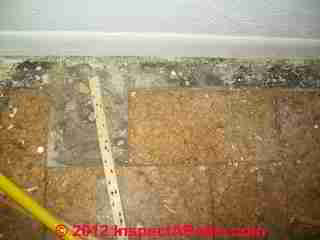 I have a bedroom that smells of mildew and I know the room flooded once before we moved in. There are 2 asthmatics who live in the house so I pulled up carpet and pad.
I have a bedroom that smells of mildew and I know the room flooded once before we moved in. There are 2 asthmatics who live in the house so I pulled up carpet and pad.
I found several pounds of sandy fine dirt underneath and decayed tiles. I never thought about asbestos until I got to the tile.
I figured it would be cement foundation. I have looked at the different websites and not seen this particular tile and are kind of afraid to touch it now. I want so badly to clean with soap, water, and bleach but are unsure if it is safe?
[I have provided some photos including the one shown at left]
I live in an extremely humid south-texas area and my home was built in 1955 so the deed says.
If you have any advice for me
I would appreciate it very much. Right now my husband is in the hospital with pneumonia so I am trying to rid our home of any possible mildew before he comes home. - D.R.R. 8/26/2012
Reply:
You are describing two different concerns: possible asbestos contamination from asbestos containing floor tiles under a carpet, and mold odors and a possible mold contamination problem in the building.
How to deal with asbestos-suspect floor tiles
The floor tiles in your (blurry so I'm unsure) photos look like vinyl flooring tiles that were made to resemble cork flooring. Some of these, depending on age, contain asbestos as fibers and filler.
Asbestos is safe and legal to remain in homes or public buildings as long as the asbestos materials are in good condition and the asbestos can not be released into the air.
The material in most floor tiles is not particularly friable (as long as you're not doing a messy demolition), and asbestos release from such tiles while covered by carpeting would most likely be below the limits of detection.
More likely the dirt and debris you found atop the floor is soil that came through the overlaying carpeting, or it may be from deteriorating carpet backing or carpet padding.
Best bet is to dispose of old, questionable carpets entirely, HEPA vacuum and damp-wipe clean the entire area.
Also see
ASBESTOS FLOORING HAZARD LEVEL ASSESSMENT
ASBESTOS FLOORING REMOVAL GUIDE.
Readers who are considering removing asbestos containing materials should also
see ASBESTOS REMOVAL, WETTING GUIDELINES.
How to deal with a possible indoor mold problem in the same area as the asbestos-suspect floor tiles
Because you note that a family member suffers from a respiratory illness, thus increasing the risks involved, you'll want to address household dust levels overall as well as a possible mold concern.
Ask your physician for specific advice about exposures, risks, and cleaning in the home. To further address a possible mold contamination problem you'll need to:
- Inspect for visible mold and remove or clean that mold up. Using bleach to "kill" mold is not necessary (MOLD KILLING GUIDE) but cleaning the moldy surfaces and removing moldy material that can't be cleaned are the basic approach.
See also MOLD CLEANUP, DO IT YOURSELF - Identify possible areas of hidden mold contamination and decide if further investigation is warranted.
See MOLD / ENVIRONMENTAL EXPERT, HIRE ? for help in deciding if it's cost justified and appropriate to bring in an expert.
In my OPINION, given the history of flooding in the home, the mold smells, and the respiratory illness of a family member, it's likely that a thorough professional inspection is justified.
Do not just "do a mold test" as a "test" alone would be unreliable and even if it indicated a problem you'd be no wiser about where to start investigating more thoroughly nor how to remove and clean up the problem. - Identify possible or most likely causes of high indoor moisture or leaks and correct those - as indoor moisture is a gating factor in indoor mold growth. It may be as simple as installing a self-draining dehumidifier in the basement, but a more through building inspection may be appropriate.
Question: how do I know if the flooring in our house is safe or is an asbestos hazard?
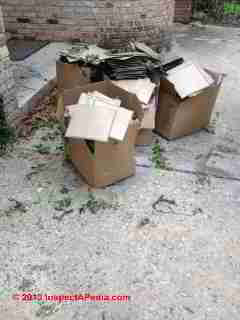
I would appreciate your help. I purchased a home that was built in the 1970's and recently had water damage and the insurance adjuster asked me to remove the tile so that the flooring underneath could dry.
I removed the flooring myself and now I have learned it may have asbestos. How do I tell and am I or my children in any danger because of this?
Reply:
Your photo shows a bunch of what looks like vinyl tiles in boxes outdoors; from the photo I'm doubtful anyone could or even should try to identify exactly what tile this is, nor assert whether the tile in the photo (or other unseen flooring in your house) has asbestos or not.
If you knew the age of the flooring in the home (prior to early 80's) it would be reasonable (and safe) to treat the flooring as presumed asbestos-containing floor tile (PACM).
If you recognized a specific tile pattern in our online photo guide to asbestos tile you would know more certainly just what's probably there (some look like others);
Or you'd need to send a sample to a certified asbestos test lab (we list those contacts too at InspectApedia);
For a floor that is in place, intact, and is not being ground up or smashed about by demolition the level of risk is probably below the limits of detection.
For floor tiles that came up intact as those in your photo the quantity of asbestos fiber release should also be very low, as you were not breaking up the tiles; floor tiles are not friable - are not easily crumbled into dangerous dust.
Watch out: some floor tile mastics also contained asbestos filler or fibers. Beyond demolition or grinding or chopping PACM floor tiles, the greatest hazard you might create in any event would be running a conventional vacuum cleaner, thus blowing dust and (if present) asbestos particles into the building air.
In the article above ASBESTOS FLOORING HAZARD REDUCTION (found if you search InspectApedia.com for "asbestos floor tile hazard reduction") you'll see expert advice on what to do to minimize the hazard from asbestos containing floor tiles or PACM.
Watch out: If in your home there remains flood-damaged flooring that is loose or damaged and has to be removed and you want to minimize risk of possible stirring up of asbestos containing dust, also
see ASBESTOS FLOORING REMOVAL GUIDE.
Question: signs of amateur and incomplete asbestos removal - what now?
I cam across your website while searching the internet about asbestos and had a couple of questions.
I bought a house 3 years ago and my husband ripped up the carpet in the basement. underneath were tiles that looked like they may be asbestos tiles, so we had a certified company come in and clean up the broken tiles. we then laid carpet over the remaining tiles
I noticed recently that in the utility closet there seems to be small pieces of what looks like that tile on the floor, maybe left from a past contruction job the previous owner did. I would like to just paint over the floor to adhere anything that might be dangerous. is that a good option?
Also, the owner has a heat pipe running through the basment that was wrapped in asbestos. she seems to have had it removed and then built a sort of wooden enclsure from the ceiling around the pipe. I looked inside and can see from one of the openings a small piece of wrapping still remains.
About a foot long. it looks like it has a honeycomb shape. half of it is off the pipe resting on the wooden enclosure covered in years of dust. can I just leave it alone? do I need to have it removed? it will be difficult to access it without removing some of the wooden enclosure. - S.D. 7/16/2013
Reply:
S.D. please take a look at ASBESTOS FLOORING HAZARD REDUCTION -
where you'll see that painting over a floor consists of resilient tiles that are suspected of containing asbestos and that is securely bonded to its base is a possible option.
The other details you include describe clues of an amateur asbstos removal job - incomplete, which raises the real possibility that work was done without proper dust control and containment. If you have reason to be concerned you might want to test the home for problematic levels of contaminted dust, or save your test money and pu it twoards more expert and thorough cleaning - discuss these options with your cleanup company.
Watch out: No one can safely offer any conclusions about the level of asbestos contamination or anything else in a home just based on an email conversation, but in general, even many asbestos materials can often be left safely in place, in fact with less risk of building contamination than if the materials are removed, provided they are encapsulated and are in an area where they will not be disturbed.
Watch out: I would be more concerned about exposed friable asbestos materials in an occupied space or in the air path of HVAC equipment than in an enclosed pipe chase, for example. But I'd keep in mind that even asbestos left within an enclosed pipe chase may present extra costs when sooner or later someone needs to perform plumging or other work in that very area.
...
Continue reading at ASBESTOS FLOORING LEFT IN PLACE - topic home, or select a topic from the closely-related articles below, or see the complete ARTICLE INDEX.
Or see these
Recommended Articles
- ASBESTOS FLOORING HAZARD REDUCTION - home
- ASBESTOS FLOORING IDENTIFICATION
- ASBESTOS FLOORING HAZARD LEVEL ASSESSMENT
- ASBESTOS DISPOSAL REGULATIONS
- ASBESTOS FLOORING LEFT IN PLACE using an expoxy floor paint over asbestos-containing floor tiles or sheet flooring.
- ASBESTOS FLOORING REMOVAL GUIDE
- ASBESTOS LEFT in PLACE in BUILDINGS - MANAGEMENT GUIDES - codes, regulations, procedures
- ASBESTOS REMOVAL, WETTING GUIDELINES
- DOES THIS FLOOR CONTAIN ASBESTOS? - 5 easy questions to tell if your FLOOR probably contains asbestos -
- RESILIENT FLOORING VINYL or CORK installation
Suggested citation for this web page
ASBESTOS FLOORING LEFT IN PLACE FAQs at InspectApedia.com - online encyclopedia of building & environmental inspection, testing, diagnosis, repair, & problem prevention advice.Or see this
INDEX to RELATED ARTICLES: ARTICLE INDEX to ASBESTOS HAZARDS
Or use the SEARCH BOX found below to Ask a Question or Search InspectApedia
Ask a Question or Search InspectApedia
Questions & answers on how to minimize the risk of asbestos contamination in a building due to the presence of asbestos-containing floor tiles or asbestos-suspect floor tile coverings. Use the "Click to Show or Hide FAQs" link just above to see recently-posted questions, comments, replies, try the search box just below, or if you prefer, post a question or comment in the Comments box below and we will respond promptly.Search the InspectApedia website
Note: appearance of your Comment below may be delayed: if your comment contains an image, photograph, web link, or text that looks to the software as if it might be a web link, your posting will appear after it has been approved by a moderator. Apologies for the delay.
Only one image can be added per comment but you can post as many comments, and therefore images, as you like.
You will not receive a notification when a response to your question has been posted.
Please bookmark this page to make it easy for you to check back for our response.
IF above you see "Comment Form is loading comments..." then COMMENT BOX - countable.ca / bawkbox.com IS NOT WORKING.
In any case you are welcome to send an email directly to us at InspectApedia.com at editor@inspectApedia.com
We'll reply to you directly. Please help us help you by noting, in your email, the URL of the InspectApedia page where you wanted to comment.
Citations & References
In addition to any citations in the article above, a full list is available on request.
- In addition to citations & references found in this article, see the research citations given at the end of the related articles found at our suggested
CONTINUE READING or RECOMMENDED ARTICLES.
- Carson, Dunlop & Associates Ltd., 120 Carlton Street Suite 407, Toronto ON M5A 4K2. Tel: (416) 964-9415 1-800-268-7070 Email: info@carsondunlop.com. Alan Carson is a past president of ASHI, the American Society of Home Inspectors.
Thanks to Alan Carson and Bob Dunlop, for permission for InspectAPedia to use text excerpts from The HOME REFERENCE BOOK - the Encyclopedia of Homes and to use illustrations from The ILLUSTRATED HOME .
Carson Dunlop Associates provides extensive home inspection education and report writing material. In gratitude we provide links to tsome Carson Dunlop Associates products and services.


